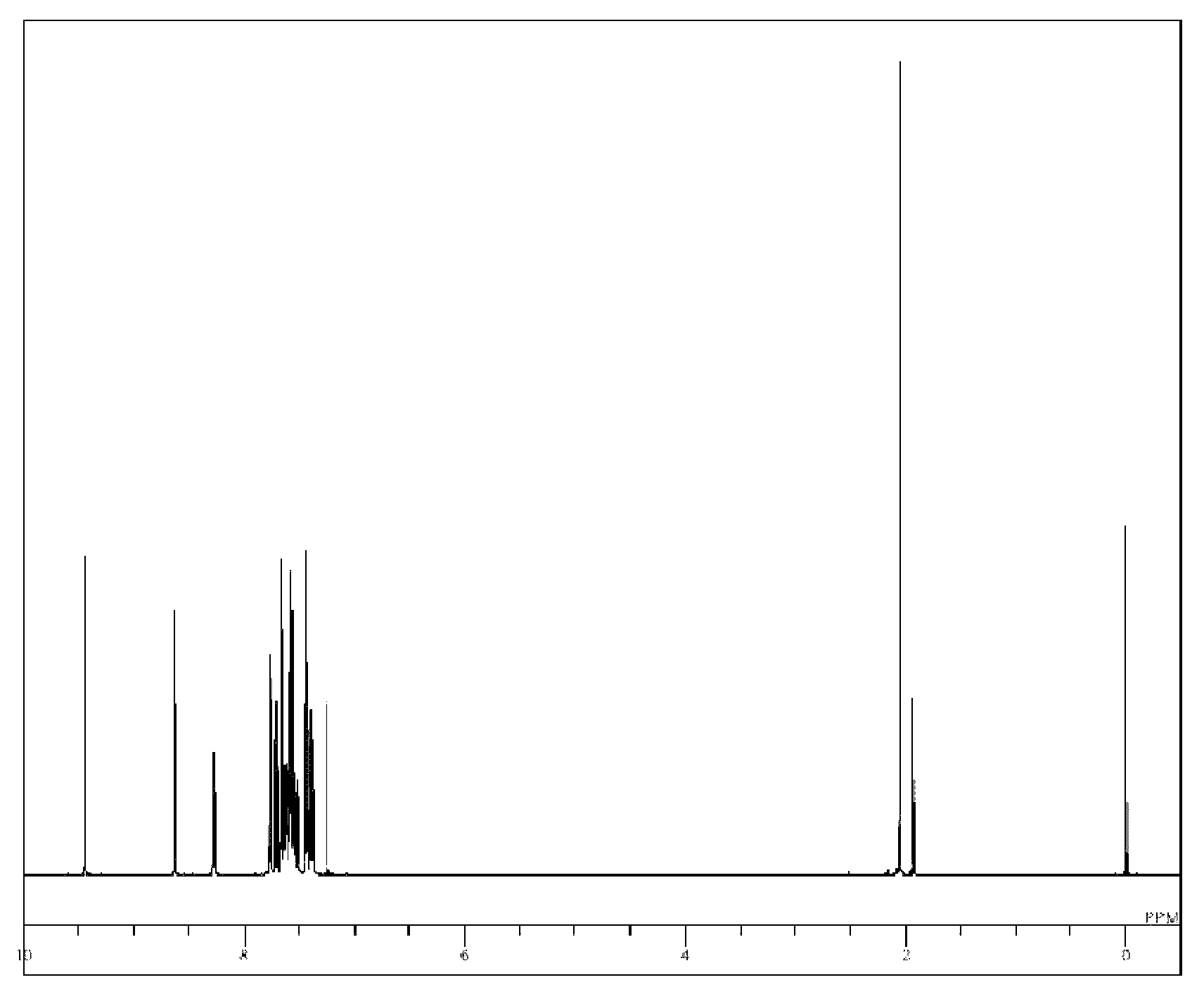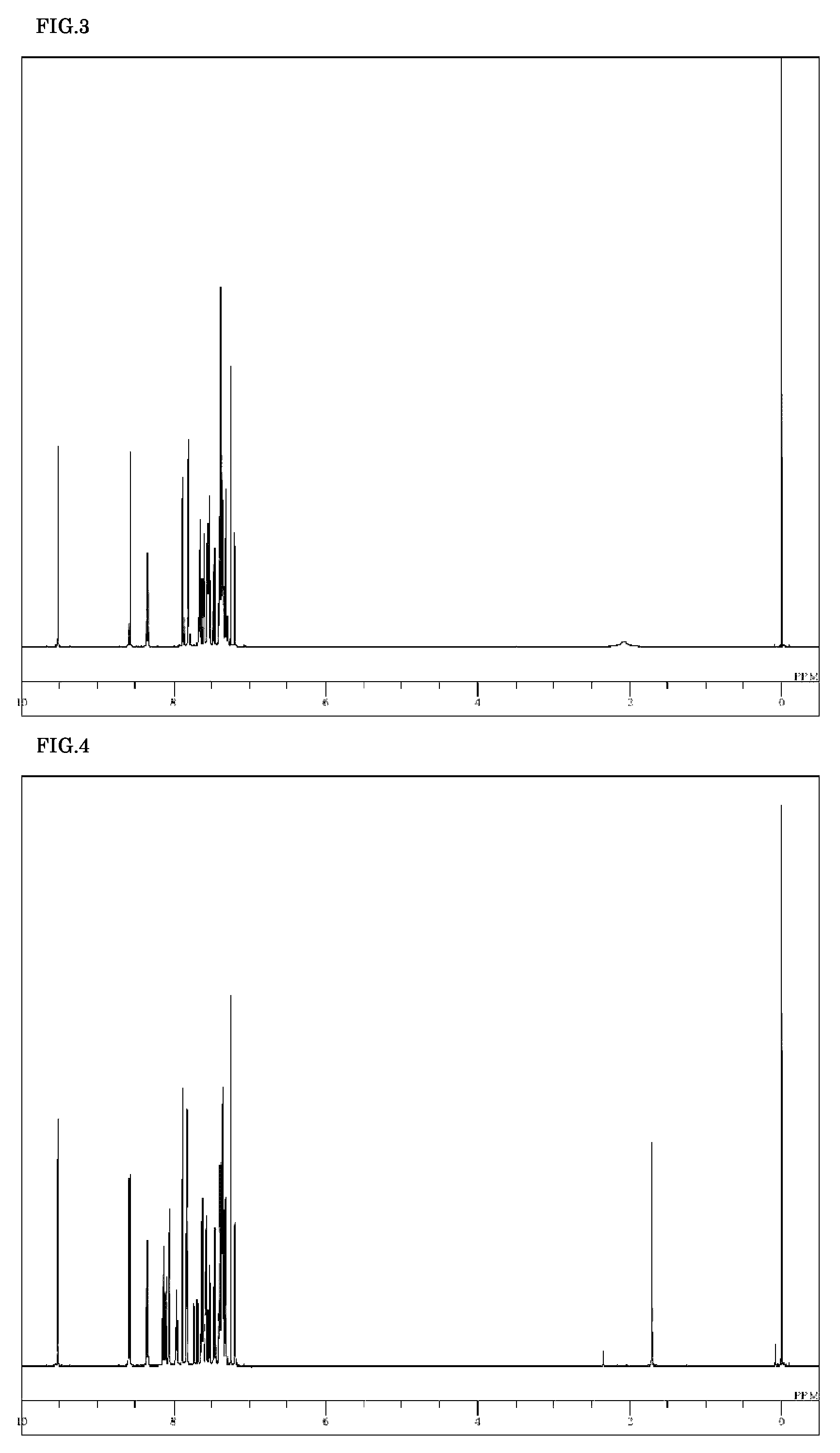Compound having substituted anthracene ring structure and pyridoindole ring structure, and organic electroluminescent device
a technology of pyridoindole and pyridoindole, which is applied in the field of compounds, can solve the problems of poor electron transportability, low efficiency, and material that cannot be said to have hole blocking performance, and achieve excellent hole blocking ability, stable thin-film state, and heat resistance. excellent
- Summary
- Abstract
- Description
- Claims
- Application Information
AI Technical Summary
Benefits of technology
Problems solved by technology
Method used
Image
Examples
example 1
Synthesis of 5-[3-methyl-4-(10-phenylanthracen-9-yl)phenyl]-5H-pyrido[4,3-b]indole (Compound 9)
[0073]5-(4-Bromo-3-methylphenyl)-5H-pyrido[4,3-b]indole (3.3 g), 9-(4,4,5,5-tetramethyl-[1,3,2]dioxabororan-2-yl)-10-phenylanthracene (3.7 g), tetrakis(triphenylphosphine)palladium (0.57 g), a 2 M potassium carbonate aqueous solution (24 ml), toluene (80 ml), and ethanol (20 ml) were added to a nitrogen-substituted reaction vessel, heated, and refluxed for 16 hours while being stirred. The mixture was cooled to room temperature, and stirred after adding toluene (100 ml) and water (100 ml) to separate the organic layer. The organic layer was dehydrated with anhydrous magnesium sulfate, and concentrated under reduced pressure to obtain a crude product. The crude product was purified by column chromatography (carrier: NH silica gel; eluent: toluene / hexane) to obtain a pale yellow powder of 5-[3-methyl-4-(10-phenylanthracen-9-yl)phenyl]-5H-pyrido[4,3-b]indole (Compound 9; 2.8 g; yield 56%).
[00...
example 2
Synthesis of 5-[3-methyl-4-{10-(naphthalen-2-yl)anthracen-9-yl}phenyl]-5H-pyrido[4,3-b]indole (Compound 10)
[0076]5-(4-Bromo-3-methylphenyl)-5H-pyrido[4,3-b]indole (2.4 g), 9-(4,4,5,5-tetramethyl-[1,3,2]dioxabororan-2-yl)-10-(naphthalen-2-yl)anthracene (3.7 g), tetrakis(triphenylphosphine)palladium (0.41 g), a 2 M potassium carbonate aqueous solution (18 ml), toluene (64 ml), and ethanol (16 ml) were added to a nitrogen-substituted reaction vessel, heated, and refluxed for 16 hours while being stirred. The mixture was cooled to room temperature, and stirred after adding toluene (100 ml) and water (100 ml) to separate the organic layer. The organic layer was dehydrated with anhydrous magnesium sulfate, and concentrated under reduced pressure to obtain a crude product. The crude product was purified by column chromatography (carrier: NH silica gel; eluent: toluene / cyclohexane) to obtain a pale yellow powder of 5-[3-methyl-4-{10-(naphthalen-2-yl)anthracen-9-yl}phenyl]-5H-pyrido[4,3-b]in...
example 3
Synthesis of 5-[4-(10-phenylanthracen-9-yl)naphthalen-1-yl]-5H-pyrido[4,3-b]indole (Compound 42)
[0080]5-(4-Bromonaphthalen-1-yl)-5H-pyrido[4,3-b]indole (3.1 g), 10-phenylanthracene-9-boronic acid (3.0 g), tetrakis(triphenylphosphine)palladium (0.48 g), a 2 M potassium carbonate aqueous solution (21 ml), toluene (70 ml), and ethanol (18 ml) were added to a nitrogen-substituted reaction vessel, heated, refluxed for 6 hours while being stirred. The mixture was cooled to room temperature, and the deposit was collected by filtration. The deposit was dissolved under heat in o-dichlorobenzene, and, after removing the insolubles by filtration, the filtrate was concentrated under reduced pressure to obtain a crude product. The crude product was purified by o-dichlorobenzene / ethyl acetate recrystallization to obtain a yellow powder of 5-[4-(10-phenylanthracen-9-yl)naphthalen-1-yl]-5H-pyrido[4,3-b]indole (Compound 42; 1.6 g; yield 36%).
[0081]The structure of the resulting yellow powder was ide...
PUM
 Login to View More
Login to View More Abstract
Description
Claims
Application Information
 Login to View More
Login to View More - R&D
- Intellectual Property
- Life Sciences
- Materials
- Tech Scout
- Unparalleled Data Quality
- Higher Quality Content
- 60% Fewer Hallucinations
Browse by: Latest US Patents, China's latest patents, Technical Efficacy Thesaurus, Application Domain, Technology Topic, Popular Technical Reports.
© 2025 PatSnap. All rights reserved.Legal|Privacy policy|Modern Slavery Act Transparency Statement|Sitemap|About US| Contact US: help@patsnap.com



